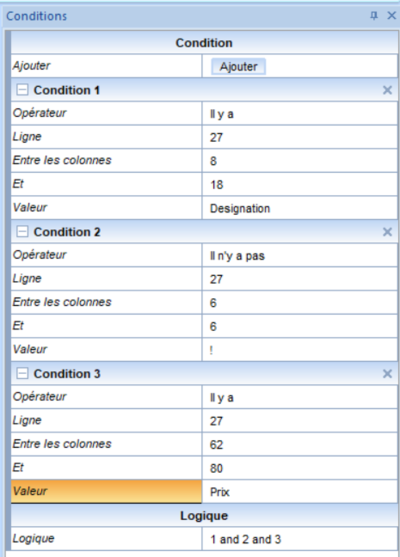OPALE - 10.0 - Utilisation - filtre de condition/en
Différence entre versions
(Page créée avec « The different filters of a condition are linked together by logical operators: '''AND''' and '''OR'''. Brackets can be used in this operation. ») |
(Page créée avec « The logical operators '''AND''' and '''OR''' can be entered in uppercase or lowercase. ») |
||
| (2 révisions intermédiaires par le même utilisateur non affichées) | |||
| Ligne 64 : | Ligne 64 : | ||
| − | + | The default logical operator between each filter is '''AND'''. By default, when four condition filters are applied, the operation is run as 1 and 2 and 3 and 4. | |
| − | + | The filter will not be deleted when deleting a filter number and a logical operator. They will automatically be filled in, in the operation. | |
| − | + | The logical operators '''AND''' and '''OR''' can be entered in uppercase or lowercase. | |
Version actuelle datée du 22 juillet 2019 à 08:26
Type in the parameters of the condition to apply:
- Comparison type: there is, there is not, greater than, less than..
- Line to test: precise number, current line, related lines
- Columns to test: beginning column and end column
- Value to test: 15 characters maximum, be careful of case sensitivity
- Logic: logical operators between each filter (AND, OR, brackets)
Comparison type
To be tested there is in the line: there is in a line or in the page there is not in the line: there is not in a line or in the page greater than (numerical): > greater than or equal to (numerical): => less than (numerical): < less than or equal to (numerical): =< the number of the page: Page the number of the line: Line
Line to test
If the object is fixed (does not belong to a group), in the drop down menu, select the number of the line to test or all the lines to search for the value in the page.
If the object belongs to a group, in the drop down menu, you can select:
- the current line (by default)
- relative lines
- the line in the spooled file
current line
The value is tested on the line which is currently run by the group. Values are tested individually, one after the other on each line of the group. The object appears for each line of the group where the condition tested is true.
relative lines
The value is tested on lines -1,-2,...,-200 or +1,+2,...,+200 depending on the line which is currently run by the group. If the group is currently running line 30 and the line being tested is "-2", the value is tested on line 28.
line in the spooled file
The value is tested on a line in the spooled file (line belonging to the group or not). If the condition tested is true, the object appears on each line of the group. Otherwise, the object is never run.
Columns to test
Enter the columns between which the test is run.
Specify the columns where the value is (filter 1 and 2 in the previous example) or a range of columns between which it is (filter 3).
In filter 3, the condition is true if the value "Price" is between the columns 62 and 65 or 63 and 66 or ... or 77 and 80.
Logical operators in a condition
The different filters of a condition are linked together by logical operators: AND and OR. Brackets can be used in this operation.
The default logical operator between each filter is AND. By default, when four condition filters are applied, the operation is run as 1 and 2 and 3 and 4.
The filter will not be deleted when deleting a filter number and a logical operator. They will automatically be filled in, in the operation.
The logical operators AND and OR can be entered in uppercase or lowercase.
